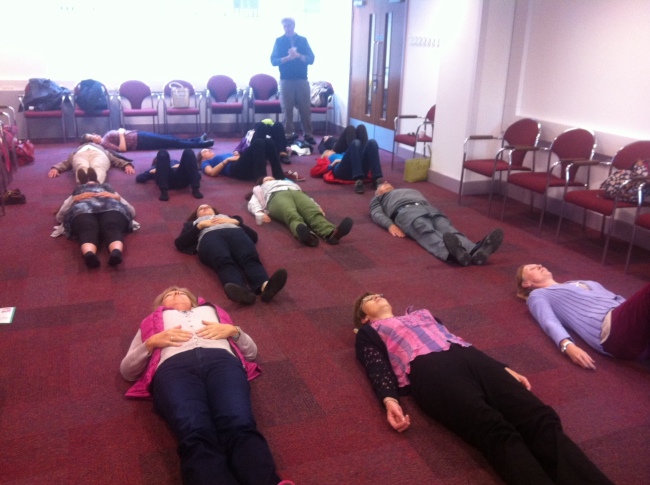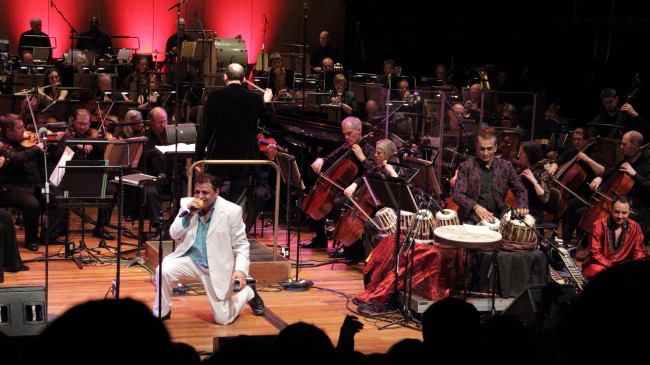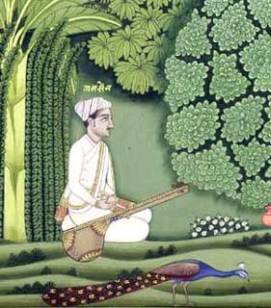Exploring the Singing voice: From head to toe
9 12 2013Comments : Leave a Comment »
Categories : Uncategorized
MAHOTSAV AT THE BHAVAN
23 08 2013Long gone are the days where you had to travel to the Indian sub-continent to see your favourite singer, musician or dancer. Over the years, the UK has built up its reputation as a destination for all top most artistes to perform, and delight some of the most excitable and welcoming crowds in the world. Right from Pandit Ravi Shankar, Ustad Nusrat Fateh Ali Khan, Lata Mangeshkar, Balamurali Krishna, Alarmel Valli, to Pandit Hariprasad Chaurasia and Birju Maharaj. Truth be told, it maybe easier for you to see greats of the industry perform their magic in the UK than you are in India. And what’s more, this year one of the largest centres for Indian culture in the country staged a major music and dance festival.
The Bhavan – which is so fortunately placed right in the centre of a major cultural capital – was the backdrop for MAHOTSAV on 20th July 2013. The Bhavan Centre threw open its doors and performance spaces to some of the most enigmatic artistes all under one roof, and on the same day. It was an event where connoisseurs of Indian culture got a unique chance to discover the very best talent in the UK today. The festival which is in its third year was this time round curated by major arts organisation Milapfest, which is based in Liverpool. Charged with the responsibility of showcasing emerging as well as established artistes, Milapfest helped create one of the best line ups to a festival in recent times. There was a real mix of singers, dancers and musicians, who all had their own unique and individual style.
The day kicked off with a traditional classical Kathak performance by dancing sensation Karan Pangali. The young performer, who’s been making a mark in India over the last year or so through reality TV show “Just Dance”, gave an eye opening and striking performance. It was a polished act which was very authentic and traditional. Perhaps his decision to stick to a strictly classical repertoire was a conscious one, given the performance was at the very home of traditional Indian dance and music. The grand Mountbatten auditorium was the stage for so many more stunning dance performances throughout the day. Audiences were unanimous in their praise for another young and expressive Bharatanatyam dancer Apoorva Jayaraman. Her showcase was described as a piece of stunning creative work. Bharatanatyam Guru Vijaya Martanda – who is currently teaching the Bhavan’s annual three week Summer School – called the performance powerful.
The festival culminated in a truly mesmerising and enchanting set by nephew of legendary flautist Pandit Hariprasad Chaurasia. The audience watching Rakesh Chaurasia’s performance were treated to something really special, so much so, they refused to leave their seats after he had finished. They demanded an encore, something which he gave into, all too easily. The Executive Director of the Bhavan Dr Nandakumara gave a special thanks to Dr Prashant Nayak, Director of Milapfest, He also thanked the Arts Council whose regular contribution helps support the Bhavan’s activities and helps achieve its aims in promoting and preserving Indian art and culture. And if this weekend’s Mahotsav was anything to go by, Indian heritage in this country is in very good hands indeed.
Lots more events like this on all year round at the largest institute for Indian music and dance in the heart of London. Check out the Bhavan Centre www.bhavan.net
Comments : Leave a Comment »
Tags: bharatanatyam, carnatic, hindustani, indian classical music; sitar, karnatic, kathak, tabla
Categories : Uncategorized
BOLLYWOOD TO HOLLYWOOD AT THE SOUTHBANK CENTRE
23 08 2013If you’re a lover of Indian Cinema or its music, then 2013 is the year that keeps on giving. Top musicians, movies makers and producers have been, and continue to, pay tribute to the largest film industry in the world. Why? Well, 2013 marks one hundred years since the first feature length Hindi film was made. Producer and musician Kuljit Bhamra, is one such man, who’s been kept incredibly busy because of the centenary. In the first half of the year alone, he’s been working on two massive events in the cultural calendar, paying homage to the world famous Bombay talkies.
The Alchemy festival at the Southbank Centre – a celebration of all things cultural from the Indian sub-continent – is where it called kicked off for him. Bollywood to Hollywood, a closer to the annual festival was an evening of “Bollywood glitz and glamour, with flashy, catchy hits from the very best swashbuckling saga.” It was a collaboration by the BBC Concert Orchestra, conducted by Robert Ziegler and other high-profile musicians and singers. The idea was the brainchild of musician, composer and producer Kuljit Bhamra, who’s also an adviser on the committee for the Alchemy festival.
He says he was pretty clear about what he wanted to get across from the show: “Indian people love Bollywood music, and one of the biggest components of this music is strings. So I wanted to orchestrate Indian music and develop audiences so that they would become more familiar with how it’s all put together.” Like many musicians who have grown up with both Indian and Western classical traditions, he consistently tries to combine the two to create something fresh. Back in 2009, he successfully produced a show in which he combined Indian Ragas together with orchestral music for a concept called Raaga Mela. He says he wanted to bring ragas to a wider audience, but knew it was a risky task, as it could lead to some contradictions. Indian music is linear, a raga is a scale, instructions or rules on how to improvise, with no set repertoire which is different to Western music where everything is written down. He explains: “There is no harmony or counterpoint in Indian classical – so that was definitely a challenge. But I made sure that I was following the rules of the Raag”.
He found fame in the early eighies, popularising Bhangra music with some of his massive hits like Rail gaddi and Pyar ka hai bairi. But never one to shy away from a challenge, he once again decided to mix things up and try something new. He says: “I wanted to get all the old school artistes together to sing their hits with an Orchestra, this was very much the first time anyone has orchestrated Bhangra music”. He admits he is less enamoured by Bhangra nowadays, but says there’s no denying Bhangra is essentially a British export to India. A sure fire way to get yourself a Bollywood hit today according to him, is throw in some Bhangra beats, with a couple of catchy Punjabi lyrics for good measure. He’s worked with some of the best in the business, none more so than the godfather of musicals, Sir Andrew Lloyd Webber, for West End musical Bollywood Dreams. Back in 2010, he also launched a exhibition about his hometown called Southall Story – a project celebrating achievements of people from there. It was opened by another resident of Southall, film director Gurinder Chadha, at the Alchemy festival that year. Born in Africa but raised in Southall, he has eternal pride for his hometown. He’s never too shy to admit where he’s from, happily calling it the best place on earth.
Kuljit Bhamra’s philosophy on music is also quite an outspoken but liberating one. “If I’m going to spend time making and producing a piece of work, I want to make sure as many people hear it. Somemay say I think about the audience too much and that I’m too commercial, but I do want to feel like my work is affecting and inspiring audiences.” For him when it comes to music, he is says it’s all pretty simple. “Live music is important and people coming to concerts is essential.” As much as technology has made life easier for musicians like him, it’s obvious that it’s a blessing as well as a curse. He explains: “Before, if you bought a CD you could hold it, read about the artiste, the tracks. But on an mp3, there’s nothing which tells you how it’s made, it’s just a file on your computer. People meet me on the streets and often ask me, where do get your beats from? And I say, well I play them”. For many music is a file that you download, the concept of making music is completely lost on some, he wants to take this back to basis. He is an educationalist and mentor at heart. In his various roles in education, he encourages as many people to try their hand at playing an instrument, and really understand the art.
But as for his immediate plans, he is busy putting the finishing touches to another ground-breaking project, in which he’s composing an original score to a live Bollywood-style production of the opera Carmen. The score will include new musical commissions and pop-song mashups. Commissioned by BBC Three and BBC North, it will be a live event following the story of young Karmen from Bradford, who is bored of her job and fantasises about becoming a movie star. The line-up includes a dazzling cast, with Eastender Preeya Kalidas, Indian film actor Abhay Deol, along with Chelsee Healey of Waterloo Road fame, Bollywood dancer Sofia Hayat amongst a dozen others. As for the future, there’s no doubt he’s got some more exciting and innovative projects up his sleeves. But until then, look out for Carmen, which will be held in Bradford’s City Park on 9th June.
Comments : Leave a Comment »
Tags: kuljit bhamra; indian; cinema; tabla; sitar; bollywood; music; film songs; indian classical music
Categories : Uncategorized
The passing of a legend: Pandit Ravi Shankar remembered
8 04 2013Here’s my little attempt at compiling just some of the tributes to this musical great. The memorial took place at the Bhavan Centre in London on the 24th February, where Pandit Ravi Shankar had been patron.
Comments : Leave a Comment »
Tags: bhavan, music, Ravi Shankar, sitar
Categories : Uncategorized
Back to the beginning
17 12 2012I’ve always loved history, but in the last two months, my passion for it has been re-kindled thanks to someone who is quite simply one of the most enchanting speakers I have had the pleasure to listen to. Dr Jameela Siddiqi’s course on Hindustani Music: History, Theory and Practise at the Bhavan Centre in London, is a fascinating, colourful, and sometimes violent ride through India’s incredibly rich past, all the while intertwined with the most important element, I think, and that is its vast cultural heritage.
Initially as a student of Hindustani (North Indian) vocal music, I never really had that much of an interest in investigating the history of the music I was learning so avidly. However, over the last few years I had started to get inquisitive, wondering about what I was singing, and how it came to be in its current form – longing to learn more. I have a theory about my recent fascination with wanting to know more. It’s almost like an an adoptive child wanting to finally find out where they came from, trying to get to the bottom of why they are, the way there are. For me, I feel like this course has set me on a path, into the direction where I want to delve into the past.
The lectures itself are a feast for connoisseurs of history, it’s a swashbuckling ride into the deep and dark past. From the Turkish invasion of the Indian sub-continent (which led to the translation of many ancient musical forms to the language and music of the people), to the emergence of the Mughal Dynasties (which very much helped propagate and further enhance Indian classical music as we know it).
At the end of the day, it is designed for those who are appreciators of Indian music, who may need a helping hand in order to really follow a traditional recital. And there are people like me, who are well accustomed to the music style, in practise, but need that extra dimension that will really bring to life what they are learning, giving it that much needed context. For me, learning about the challenges this form of music has undergone, makes me determined to make sure I can do all I can to make sure it survives to at least the next generation.
And yes, eventhough singing feeds my soul, it is this historic context – the understanding of the thousand year musical history – that will I am sure, continue to be a source of endless wonderment for years to come.
Comments : Leave a Comment »
Categories : Uncategorized
The Royal Albert Hall looks to the future
15 05 2012Over recent years, the state of music education in English schools has got a lot of bad press. It’s been heavily criticised for not encouraging and nurturing professional musicians enough or equipping audiences of the future to appreciate music properly. But critics would be hard-pressed to find any cause for concern if they attended the Hertfordshire music services’ gala concert at the Royal Albert Hall on 13th May 2012.
The concert was put on to showcase the work going on in schools and music centres across the county – through workshops, various orchestras and choir groups. The idea was to celebrate the extensive talent of both established and aspiring musicians, being trained under Hertfordshire’s music service. These included an impressive line-up of singer-songwriters, vocalists to young composers and instrumentalists.

One such performer was 15 year old Ije Amaechi. She was chosen to perform at the event, after winning the Hertfordshire Songwriters’ competition 2012. The GCSE student from Watford Girls Grammar school was one of only three students cherry-picked to take centre-stage at the world famous concert hall.
However, for me, the most notable contribution of the evening came from A-level music student Richard Lewis. He composed a piece which kicked off the entire evening. The item called Fanfare was selected from pieces submitted by GCSE and A level music students from across the county. The reward – the lucky winner would have the privilege of having their work played by the entire Hertfordshire schools’ symphony orchestra on the night.
As well as celebrating the talent of individuals, the concert very much reflected the passion created for music, amongst lots of other groups too. This was apparent when over two thousand students from more than 100 Hertfordshire primary schools joined together in a massed choir. The theme was songs celebrating the Olympic year, which inevitably created a sense of patriotism and a feeling of unity.
All in all, the event was a proud display of the rich diversity in music-making that the service boasts. However, the hope is this kind of initiative continues and so does the work in creating the next generation of musician.
Listen to a report featuring Ije Amaechi, the singer-songwriter featured in this blog. The report aired on a radio station for the youth in Watford – Vibe 107.6fm
Comments : Leave a Comment »
Categories : Uncategorized
Hello world!
21 12 2009Welcome to WordPress.com. This is your first post. Edit or delete it and start blogging!
Comments : 1 Comment »
Categories : Uncategorized












